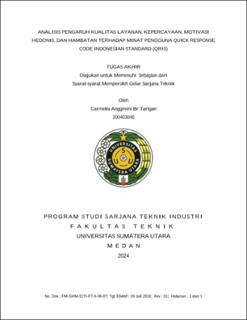| dc.description.abstract | Bank Indonesia (BI) launched the Quick Response Code Indonesian Standard (QRIS) payment system on August 17 2019 to increase the efficiency of payment infrastructure through the QR Code standard. In 2023, BI has set a target of "QRIS 45 Million New Users" and "QRIS 1 Billion Transactions" which will be distributed to the entire network of Bank Indonesia Domestic Representative Offices. The target set for the KPwBI work area of North Kalimantan Province is 43.511 total new QRIS users. However, as of October 2023, the target of adding new QRIS users has not been achieved at 4.568 people or around 10.50%. Increasing the number of QRIS transactions is also carried out by increasing the number of QRIS merchants. However, the increase in the number of QRIS merchants is not significant, and has even decreased in recent months. Therefore, this research aims to propose appropriate strategies based on an analysis of the influence of service quality, trust, hedonic motivation, and obstacle on QRIS user interest in North Kalimantan. The research method uses a descriptive quantitative approach. The research population is people of productive age (15-64 years) and merchants in North Kalimantan Province. Based on the Cluster Sampling technique and Slovin Formula calculations, a sample of 400 community respondents and 100 merchant respondents were obtained. Data was collected through a questionnaire with a Likert scale and analyzed using the multiple linear regression analysis method. The research results show that service quality, trust and hedonic motivation partially have a positive and significant effect on QRIS user interest, while barriers have a negative and significant effect. Simultaneously, service quality, trust, hedonic motivation and barriers have a significant effect on QRIS user interest, with a coefficient of determination (R2) of 56,1% for public interest and 50,4% for merchant interest. Proposed appropriate strategies to increase interest in QRIS users in North Kalimantan are carried out with 4 action plan phases, namely initiation, inclusion, expansion and recognition. | en_US |


